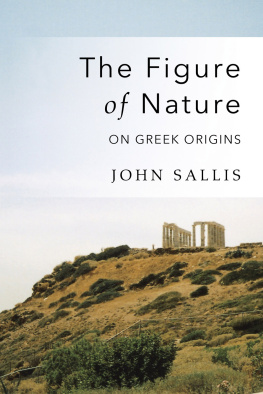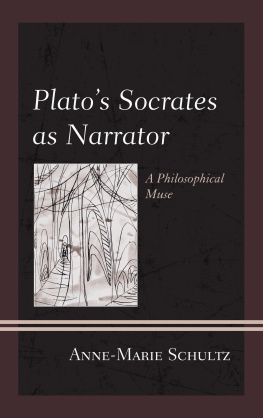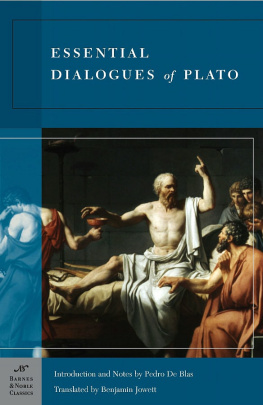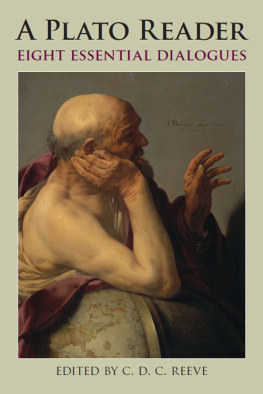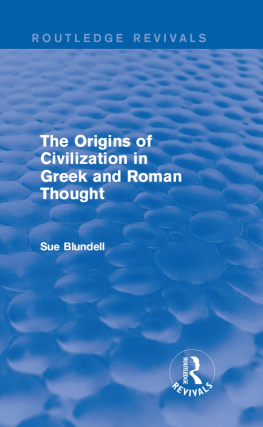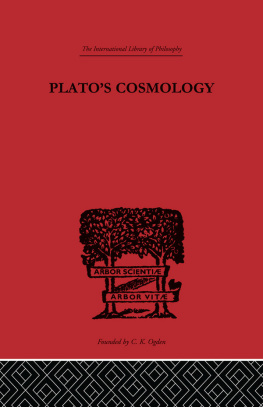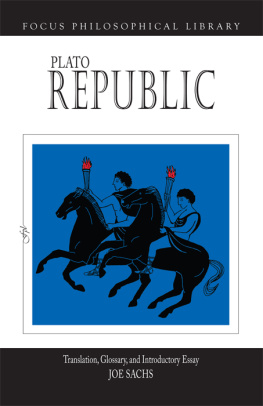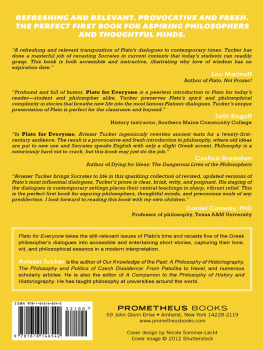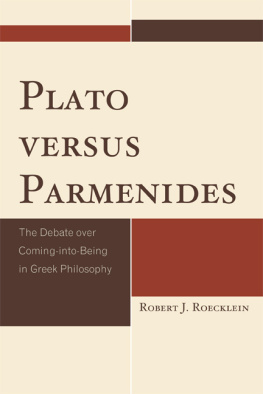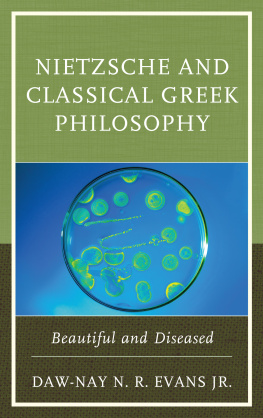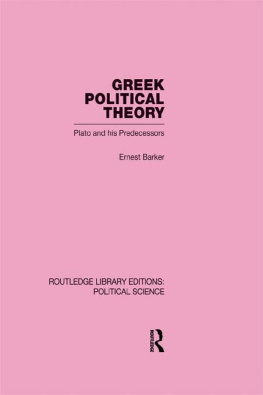Plato. - The figure of nature: on Greek origins
Here you can read online Plato. - The figure of nature: on Greek origins full text of the book (entire story) in english for free. Download pdf and epub, get meaning, cover and reviews about this ebook. City: Bloomington, year: 2016, publisher: Indiana University Press, genre: Science. Description of the work, (preface) as well as reviews are available. Best literature library LitArk.com created for fans of good reading and offers a wide selection of genres:
Romance novel
Science fiction
Adventure
Detective
Science
History
Home and family
Prose
Art
Politics
Computer
Non-fiction
Religion
Business
Children
Humor
Choose a favorite category and find really read worthwhile books. Enjoy immersion in the world of imagination, feel the emotions of the characters or learn something new for yourself, make an fascinating discovery.
- Book:The figure of nature: on Greek origins
- Author:
- Publisher:Indiana University Press
- Genre:
- Year:2016
- City:Bloomington
- Rating:4 / 5
- Favourites:Add to favourites
- Your mark:
- 80
- 1
- 2
- 3
- 4
- 5
The figure of nature: on Greek origins: summary, description and annotation
We offer to read an annotation, description, summary or preface (depends on what the author of the book "The figure of nature: on Greek origins" wrote himself). If you haven't found the necessary information about the book — write in the comments, we will try to find it.
Plato.: author's other books
Who wrote The figure of nature: on Greek origins? Find out the surname, the name of the author of the book and a list of all author's works by series.
The figure of nature: on Greek origins — read online for free the complete book (whole text) full work
Below is the text of the book, divided by pages. System saving the place of the last page read, allows you to conveniently read the book "The figure of nature: on Greek origins" online for free, without having to search again every time where you left off. Put a bookmark, and you can go to the page where you finished reading at any time.
Font size:
Interval:
Bookmark:

THE FIGURE OF NATURE
STUDIES IN CONTINENTAL THOUGHT
John Sallis, editor
CONSULTING EDITORS
Robert Bernasconi | James Risser |
John D. Caputo | Dennis J. Schmidt |
David Carr | Calvin O. Schrag |
Edward S. Casey | Charles E. Scott |
David Farrell Krell | Daniela Vallega-Neu |
Lenore Langsdorf | David Wood |
The Figure of Nature
ON GREEK ORIGINS
JOHN SALLIS
INDIANA UNIVERSITY PRESS
Bloomington & Indianapolis
This book is a publication of
Indiana University Press
Office of Scholarly Publishing
Herman B Wells Library 350
1320 East 10th Street
Bloomington, Indiana 47405 USA
iupress.indiana.edu
2016 by John Sallis
All rights reserved
No part of this book may be reproduced or utilized in any form or by any means, electronic or mechanical, including photocopying and recording, or by any information storage and retrieval system, without permission in writing from the publisher. The Association of American University Presses Resolution on Permissions constitutes the only exception to this prohibition.
The paper used in this publication meets the minimum requirements of the American National Standard for Information SciencesPermanence of Paper for Printed Library Materials, ANSI Z39.481992.
Manufactured in the United States of America
Library of Congress Cataloging-in-Publication Data
Names: Sallis, John, 1938- author.
Title: The figure of nature : on Greek origins / John Sallis.
Description: Bloomington : Indiana University Press, 2016. | Series: Studies in Continental thought | Includes bibliographical references and index.
Identifiers: LCCN 2016010955 (print) | LCCN 2016029601 (ebook) | ISBN 9780253022882 (cloth : alk. paper) | ISBN 9780253023124 (pbk. : alk. paper) | ISBN 9780253023360 (ebook)
Subjects: LCSH: Philosophy of nature. | Philosophy, Ancient. | Plato.
Classification: LCC B118 .S25 2016 (print) | LCC B118 (ebook) | DDC 113.0938dc23
LC record available at https://lccn.loc.gov/2016010955
1 2 3 4 5 21 20 19 18 17 16
Always looking toward the light of the sun.
Parmenides, Fragment B15

CONTENTS
ACKNOWLEDGMENTS
I am grateful to the editor of Internationales Jahrbuch fr Hermeneutik for permission to draw on previously published material.
All translations are my own, though I have consulted available translations, especially that of the Theaetetus by Seth Benardete and that of the Phaedo by Eva Brann, Peter Kalkavage, and Eric Salem.
For their very generous and able assistance during production of this book, I am grateful to Nancy Fedrow, Ryan Brown, and Stephen Mendelsohn. The support of my editor and friend Dee Mortensen has been indispensable, and I am especially grateful to her.
Boston
May 2016
THE FIGURE OF NATURE
PROLOGUE
To return from nature to is not merely to substitute for a modern word or concept its ancient equivalent. Rather, it is to reverse a history of translation that, beginning with the Latin rendering of as natura, has distanced what is said in the translation from what was once said in the word . In the modern designation there is borne a sedimented history of interpretation, which has both deposited senses alien to that of and rendered imperceptible much that originally sounded in the word, not least of all the echoes of mythic discourse.
To return from nature to is to venture to suspend this history so as to retrace the figure that oriented philosophy in its Greek beginning. It is to venture the attempt to write again , to span the distance in such a way that it might become possible from this distance nonetheless to reinscribe such discourse.
In orienting the discourse to the figure of nature, to its , the intent is to free nature from the weight of the concept. For is neither a concept abstracted from the many natural things ( ) nor itself one such thing alongside others. In certain respects it resembles a geometrical figure as distinct from both the corresponding concept and the visible trace that can be drawn of such a figure. This resemblance is what motivates to an extent the focus on the figure of nature, which is not something apart from nature, not something simply other than nature.
The intent is also to distance nature from anterior determinationindeed, in a double sense and manner: in such a way that, on the one side, it is not construed simply as an anterior determinant, as a nature beyond nature; and, on the other side, in such a way that, its incessant flow having been granted, its resistance to preconstituted forms and conditions is acknowledged.
Yet, even if the things of nature flow just as a flow of olive oil flows without a sound, all things whatsoeverbeing itself, , even their character as things of naturedepend on their somehow being brought back, on their being retrieved, even if in the process they undergo mutation and appear in a very different guise. There are many ways in which their retrieval can be accomplished; and these ways as they are progressively laid out constitute a fil conducteur running through the history of Greek philosophy from the Milesians up through Plato. The things of nature may be gathered into what come to be called elements, which serve to delimit nature itself; thus they may be gathered up in air or fire or in four elements intertwined like the roots of a tree. Or their flow may be interrupted by bringing a sounding to bear on them as they flow and otherwise would remain without a sound; then it is speechor rather, that conveys and, at once, evokes the stable look of things. The same capacity is displayed in thinking, the silent dialogue carried on with oneself. Memory too retrieves what is otherwise lost, bringing into the present, into presence, what has flowed away into the past.
In these ways natural things come to be manifest as what they are, as, in releasing them into presence, nature itself withdraws its very figure.
THE REIGN OF ARTEMIS |
She reigned with such sovereignty that her rule extended even into the beginning of the Christian era. It is reported that when Paul came to Ephesus, the site of the great temple of Artemis, he encountered such resistance that he dared not enter the theatre where the Ephesians were assembled. A surrogate named Alexander was thus put forth to offer a defense to the multitude assembled there. Yet when the crowd recognized that he was affiliated with Paul, then for about two hours they all with one voice cried out Great is Artemis of the Ephesians!
Her reign extended throughout Greece, from Ephesus, Miletus, and Samos, the three sites where what would be called philosophy had its beginning, to the Greek mainland and on beyond to Magna Graecia. In the recounting the deeds through which she exercised her sovereignty, her bond to , to what would come to be called nature, was paramount. In this the figure of nature was already drawn before philosophy came onto the scene and set about interrogating nature as such. When philosophy appeared on the scene, it took up this figure in which a certain sense of nature was already gathered. Even though the name Artemis goes largely unmentioned by the early Greek thinkers, the disclosure of nature sustained by her remained directive for Greek thought from its beginning on.
Next pageFont size:
Interval:
Bookmark:
Similar books «The figure of nature: on Greek origins»
Look at similar books to The figure of nature: on Greek origins. We have selected literature similar in name and meaning in the hope of providing readers with more options to find new, interesting, not yet read works.
Discussion, reviews of the book The figure of nature: on Greek origins and just readers' own opinions. Leave your comments, write what you think about the work, its meaning or the main characters. Specify what exactly you liked and what you didn't like, and why you think so.

